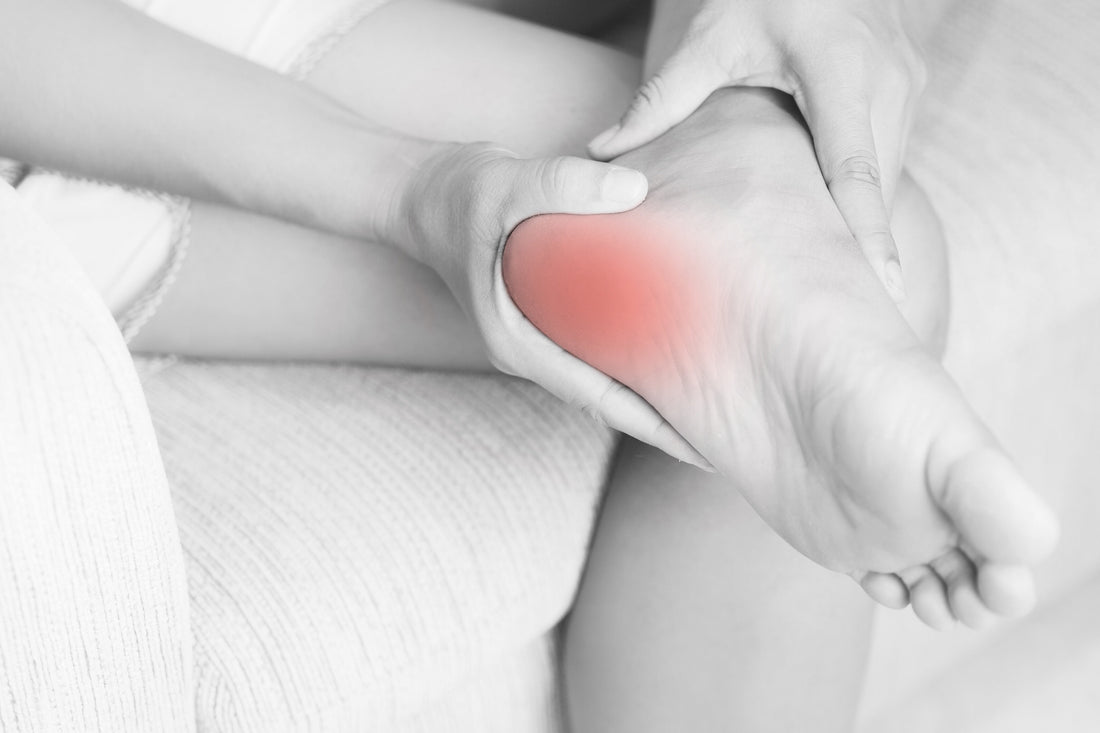
Plantar Fasciitis Relief: Podiatrist-Recommended Home & OTC Treatments
Share
🦶 Plantar Fasciitis Relief: Podiatrist-Recommended Home & OTC Treatments
Hi, I’m Dr. Ahmad Rashid DPM, board‑certified podiatrist and founder of PodiatryMarket.com. If you’re dealing with heel pain, you’re not alone—80–90% of people recover with non‑surgical (OTC/over-the-counter or home-based) treatment in just a few weeks. This guide walks you through safe, effective, easy-to-follow remedies you can start tonight—no special equipment required.
What Is Plantar Fasciitis & Why It Happens
- The plantar fascia is a thick ligament on the bottom of your foot. Tiny tears near its heel attachment can cause inflammation and pain.
- Risk factors include: tight calf muscles, arches that collapse or roll inward (over‑pronation), excess weight, or prolonged standing.
Tell‑Tale Signs (Symptoms to Watch For)
| Symptom | Description |
|---|---|
| First‑step heel pain | Sharp / stabbing in the morning or after resting |
| Warm spot under heel | Especially medial or plantar heel area |
| Pain pushing off midfoot | Feet stiff or sore with every step |
Most symptoms are plantar in origin, but if you notice tingling, numbness, or fever/light discoloration, please get evaluated by a medical professional.
Why OTC & Home-Based Treatments Can Work Well
- Research shows that consistent stretching, activity modification, and foot support resolve most cases in 6–8 weeks, especially if started early.
- American Physical Therapy Association guidelines strongly support:
- Plantar‑fascia–specific stretching + calf stretches
- Foot taping for first few weeks to relieve pain
- Foot orthoses and shoe inserts, especially when combined with stretching.
Step-by-Step Home Plan (Start Today!)
✅ Daily Routine (Morning + Evening)
1. Plantar Fascia Sstretch:
- Sit, cross affected leg. Grab toes and gently pull them toward shin for 30 seconds. Repeat 3×.
- Optional: freeze a water bottle and roll under arch for added relief. Done morning & night.
2. Calf Stretches
- Straight‑leg wall push (gastrocnemius).
- Bent‑knee wall push (soleus). 30 sec × 3 sets each, twice daily.
3. Over-the-Counter Arch Support or Heel Cups
- Use supportive, firmer (not foam) insoles with longitudinal arch support.
- Over-the-counter insoles often match custom orthotics in effectiveness for uncomplicated cases
- Wear during walking, standing, or exercise.
4. Taping (first 3–6 weeks):
- Apply low‑dye rigid tape or kinesiology tape from the arch to the back of the heel. Replace daily for pain relief and foot support.
5. Ice Massage:
- Freeze water in a disposable cup. Massage under heel/arch for 5–10 minutes. Do once daily after activity/massage every 1–2 hours if pain is intense.
6. NSAIDs (if not contraindicated):
- Ibuprofen or naproxen can help reduce pain in the first few days. Use as needed, as directed on label or by your doctor. Not for long‑term use if GI (gastrointestinal), renal (kidney), blood‑pressure or other medical related issues are present.
🛏(Optional) Evening/Night Add-On
-
Night splint (1–3 months):
- Helps gently stretch calf and plantar fascia while sleeping.
- Especially helpful if you experience sharp first‑step pain in the morning.
✅ Weekly Foot Care
- Gentle foot strengthening:
- Towel curls, marble pickups, toe spread. 2–3 sets × 10–15 reps, twice a week.
- Low-impact exercise:
- Swap one or two high-impact workouts for swimming, cycling, or elliptical until heel pain subsides.
Lifestyle Adjustments That Help
- Avoid barefoot walking on hard surfaces when you have heel pain.
- Limit activity that worsens symptoms (running, jump‑landing).
- Maintain healthy body weight—just 5–10 pounds can reduce plantar stresses by 30–40%.
- Replace worn or unsupportive shoes. Rotate footwear if you walk/run frequently.
When to See Your Doctor or Podiatrist
Check in if you’ve followed this OTC treatment plan consistently for 6–8 weeks and pain persists or worsens. Other red‑flag signs:
- Constant pain that doesn’t ease with rest
- Significant swelling, ankle/base foot numbness
- History of foot trauma or fracture
- Widespread pain across the midfoot, not isolated under the heel
Periodic check-ins allow evaluation for advanced options like injections, physical therapy, or custom orthotics.
Why Trust This Home‑Treatment Model?
- Guidelines and systematic reviews (AAFP, APTA, MEDLINE) all point to stretching + supportive footwear + taping + optional splints as effective first‑line care.
- The 2023 JOSPT clinical guideline grades night splints, taping, and stretching with strong evidence when combined—not as standalone techniques.
Products at PodiatryMarket.com for Your Recovery
(All available online at PodiatryMarket.com, links are to the product page)
-
Foot Petals Plantar Fasciitis 3/4 Orthotic
This slim ¾‑length insole combines firm arch support with slow‑recovery foam. It holds the heel cradle and fits into low‑volume shoes, helping unload the plantar fascia. Great for runners, nurses, or anyone standing long hours. -
Foot Petals Gel Heel Cup Cushion
A minimal heel‑cup cushion you stick into your shoes. It provides targeted shock absorption at heel strike and reduces calcaneal loading without bulk.
-
ZenToes Diabetic Cushioned Inserts
These contain a thick layer of shock‑absorbing plastazote foam that disperses pressure evenly and reduces friction—ideal for sensitive or swollen feet, and adds another layer of arch/heel relief.
-
ZenToes Plantar Fasciitis Compression Socks
Offers 15–20 mmHg graduated compression and built‑in support around the arch and heel. Helps reduce swelling, enhances circulation, and supports tissue recovery with a gentle taping effect. -
Pedag Outdoor Sportsline Orthotic
Robust German‑engineered full‑length insert for outdoor use. Semi‑rigid structure with a built‑in metatarsal pad and heel cup absorbs shock, stabilizes pronation, and reduces Achilles and plantar stress during hikes or long walking sessions.
pedagusa.com -
Pedag Viva Sport Orthotic
A sporty full‑length orthotic made for higher impact. It features breathable cushioning, metatarsal support, and firm but flexible arch control—ideal for workouts or extended walking. -
Pedag Viva Mini 3/4 Orthotic
Ultra‑thin leather finish and semi‑rigid arch support in a ¾ length design. Fits dress or tight shoes elegantly without compromise, and still delivers true orthotic-level support. -
Kinesiology Tape Roll (2 inches × 16 feet)
This standard kinesiology tape can be applied using low‑dye or arch fan techniques. Provides tension relief, proprioceptive feedback, and helps take load off the plantar fascia for up to 4–5 days per application. -
Mini Foot Massage Roller (Travel)
A compact roller for trigger‑point release, ideal for use under the arch or heel—even on airplane seats or desks. Use it when stretching isn't possible—it mimics ice‑bottle rolling and foot massage for symptom relief. -
Ankle Ice Pack Wrap
This slip‑on, medical‑grade gel sleeve hugs the heel, plantar fascia, and Achilles with uniform hot‑or‑cold compression—no straps or Velcro needed. It suppresses post‑walk inflammation and soothes morning stiffness in just 15‑minute sessions.
Each item is hand‑selected by me using both patient feedback and clinical evidence. Combine them with the stretches above for a powerful, conservative care routine.
Key Takeaways
- Plantar fasciitis relief often needs only stretching + ice + arch support + occasional NSAIDs.
- Home treatment works for most—taping and night splints can help those with morning or long-standing heel pain.
- Supportive footwear—including OTC orthotics & heel cups—reduce strain on the plantar fascia and support healing.
- Give this approach 6–8 weeks before seeking more advanced care. Monitor symptoms carefully.
- At PodiatryMarket.com, you’ll find trusted, medically vetted products to support this entire conservative rehabilitation plan.
✅ Final Note (Board‑Certified Advice)
This blog is educational and should help you begin portable, evidence-based care immediately. However, it's not a substitute for in‑office examination. If you have unusual symptoms or risk factors—consult in person.
Wishing you a swift recovery and foot health!
Dr. Ahmad Rashid, DPM
Board-Certified Podiatrist & Founder, PodiatryMarket.com
Disclaimer: This post is educational and not intended as a substitute for medical advice. Consult your healthcare professional for personalized recommendations.
